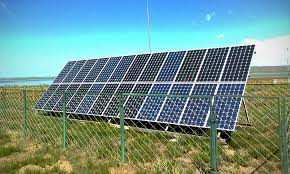How do we tap solar energy?« Back to Questions List
|
Solar energy is being used everywhere to supply all the electrical needs of houses and commercial buildings. Solar panels convert sunlight into electricity with no emissions. It is a collection of individual silicon cells. Current is produced when sunlight strikes the surface of these thin silicon wafers. Solar cells are also called photovoltaic cells. These cells are used in satellites, calculators and many other devices. Photovoltaic cells are made of special materials called semiconductors such as silicon. When light strikes the cell, a certain portion of it is absorbed within the semiconductor material. This means that the energy of the absorbed light is transferred to the semiconductor. The energy knocks electrons loose, allowing them to flow freely. A single solar cell produces only about 1/2 (.5) of a volt. However, a typical 12 volt panel (of size 25 inches by 54 inches) will contain 36 cells wired in series to produce about 17 volts peak output. Solar panels can be configured to different volt outputs depending on the number of cells that are wired in series. Similarly multiple solar cells can be wired in parallel to increase the power and wired in series to increase the voltage. The benefit of using a higher voltage output at the solar panels is that smaller wire sizes can be used to transfer the power from the panel to the load. There are three basic types of solar panels – monocrystalline, polycrystalline and amorphous panels depending on the purity of silicon used in the production of panel. Of the three, monocrystalline panels are made of pure silicon and they are the most efficient and expensive too. Polycrystalline panels also called as multi-crystalline panels consist of cells made from large blocks of many crystals (instead of a single crystal) which give them a shattered glass appearance. These are cheap and less efficient than monocrystalline panels. Amorphous ones are a thin layer of silicon deposited on a base of metal or glass to create a panel. Hence they are least efficient. They need more square footage as compared to the other two panels for the same output power.
|

